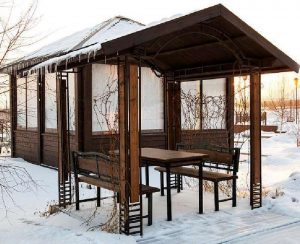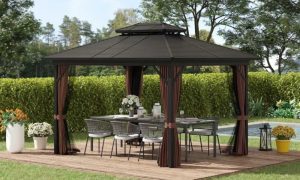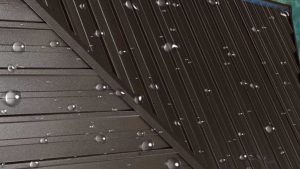A gazebo is more than just a shelter — it defines the atmosphere and character of any outdoor space. Whether placed on a small city patio or a wide-open resort lawn, a thoughtfully designed gazebo often becomes the focal point. To achieve both visual appeal and lasting performance, the frame plays a central role. As the structural backbone, it determines how the roof is supported, how the structure withstands wind, and how long it will last. It also influences upkeep requirements and the potential for future upgrades. That’s why understanding frame materials is essential — not just for landscape designers and project buyers, but also for everyday users making informed decisions.
Don’t Miss: Best Material for Gazebo Roof: 8 Types You Should Know
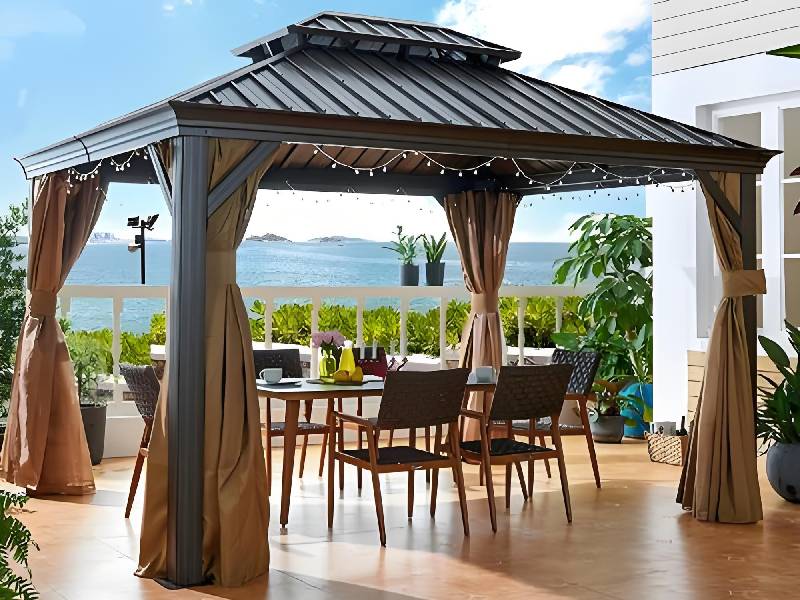
With more than 20 years of experience in gazebo exports, LIDA OUTDOOR understands that preferences for frame materials differ widely depending on the market and project type. In this guide, we’ll explore six popular frame options, giving you the insights needed to choose the one that best suits your needs.
Quick Comparison: 6 Gazebo Frame Materials
Before diving into the full breakdown, let’s start with a side-by-side comparison. This quick overview highlights key differences in strength, cost, appearance, and maintenance needs, helping you narrow down the options based on your priorities.
| Gazebo Frame Materials | Pros | Cons | Best For |
|---|---|---|---|
| Aluminum | Lightweight, rustproof, modern look | Moderate wind resistance, slightly pricier | Backyard use, portable gazebos |
| Steel | High strength, great load capacity | Heavy, prone to rust, needs coating | Commercial setups, permanent use |
| Wood | Natural beauty, customizable style | Can rot, needs regular upkeep | High-end homes, resort areas |
| Wrought Iron | Decorative, strong classic design | Very heavy, expensive, rust-prone | European gardens, public parks |
| PVC/Composites | Corrosion-resistant, low maintenance, affordable | Plastic look, moderate strength | Poolside setups, light structures |
| Concrete | Extremely stable, weather-resistant, zero maintenance | Not movable, slow to build, costly | Parks, plazas, and large permanent gazebos |
In-Depth Breakdown
Now that you’ve seen the pros, cons, and best-use scenarios of each material at a glance, you might already have a few options in mind. But a quick snapshot only tells part of the story. To truly evaluate which frame material suits your project best, especially when it comes to weather resistance, aesthetics, or long-term care, it’s worth taking a closer look. In this section, we’ll go through each material in detail so you can choose with clarity and confidence.
1. Aluminum
Aluminum is one of the most popular choices for gazebo frames today — and for good reason. It’s lightweight, rust-resistant, and well-suited to almost any climate. Unlike steel, it doesn’t rust; unlike wood, it requires far less maintenance. That’s why it’s favored by both homeowners and commercial users alike.
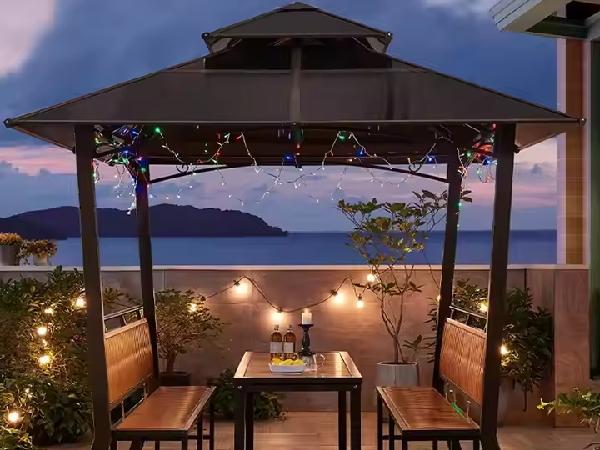
That said, aluminum doesn’t match steel when it comes to raw strength. In high-wind areas, it’s best to reinforce the frame with extra anchors or opt for thicker profiles. While it’s low-maintenance, we still recommend checking the joints periodically and tightening or reinforcing them if needed.
Aluminum frame gazebos are especially popular in modern urban backyards, rental spaces, and minimalist patio designs. Thanks to their lightweight, they’re ideal for DIY setups or temporary installations. As the market shifts toward lightweight structures with clean aesthetics, aluminum continues to gain traction in outdoor architecture.
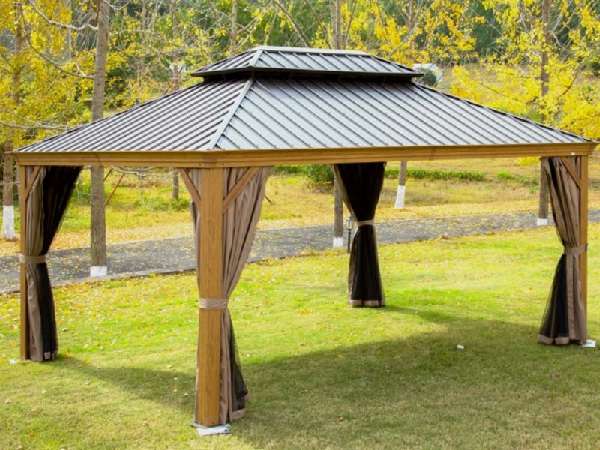
2. Steel
Steel ranks among the strongest frame materials for gazebos. It easily handles heavy loads and high winds, making it ideal for large-scale, permanent installations. Its solid structure offers top-tier stability, perfect for those dealing with extreme weather or prioritizing safety.
However, steel has one major downside: it’s prone to rust. To extend its lifespan, it must be coated or hot-dip galvanized to resist corrosion. Steel is also heavy, which means higher shipping costs and more manpower for installation. And even after setup, regular maintenance is essential to prevent rust buildup.
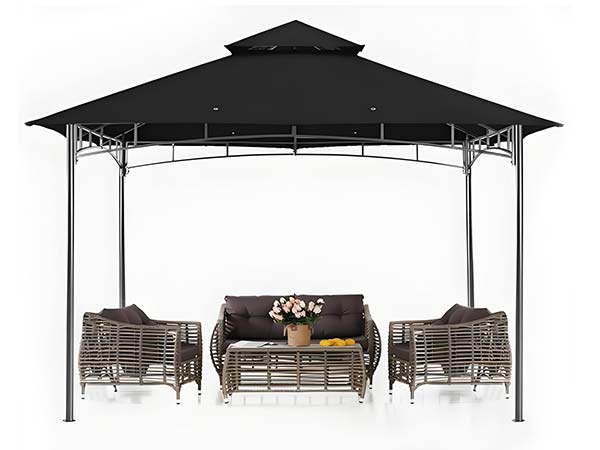
From a structural standpoint, steel is the go-to choice if wind resistance, long-term stability, and durability are your top concerns. It’s commonly used in commercial venues, outdoor BBQ areas, wind-prone regions, or any project where safety and strength are non-negotiable. Steel is especially well-suited for large gazebos that require a solid, permanent foundation.
3. Wood
Wood gazebos are the go-to favorite for those who value natural aesthetics. With warm textures and organic grain, wood blends effortlessly into gardens, backyards, and resort settings, creating a calm, nature-connected vibe. Wood is also highly customizable, allowing you to shape fine details and achieve truly unique designs.
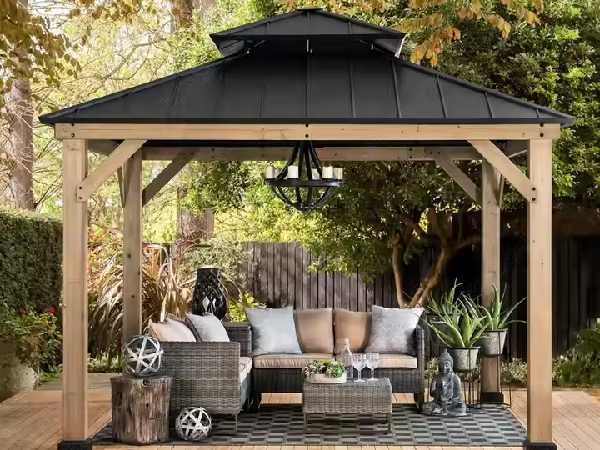
That said, wood is more delicate than metal. It’s vulnerable to moisture, insects, and long-term exposure to sun and rain. To keep it in good shape, you’ll need regular treatments such as sealing, pest control, and anti-mold coatings. Without proper maintenance, both its looks and lifespan can suffer. Overall, wood is best suited for dry climates with mild temperature shifts and for users who prioritize style and personalization. It’s a top choice for luxury residential yards, country-style gardens, and eco-friendly resort projects — perfect when “look and feel” matter just as much as function.
4. Wrought Iron
When it comes to artistry and elegance, nothing beats wrought iron. This material combines a timeless look with impressive strength. It’s dense, solid, and makes for an extremely sturdy gazebo frame, blending function with decorative flair. However, wrought iron isn’t without its downsides. It rusts easily, requires complex fabrication, and tends to be expensive. Transportation and installation are more labor-intensive. To keep it in good shape, regular maintenance is essential, including rust removal and protective coatings.
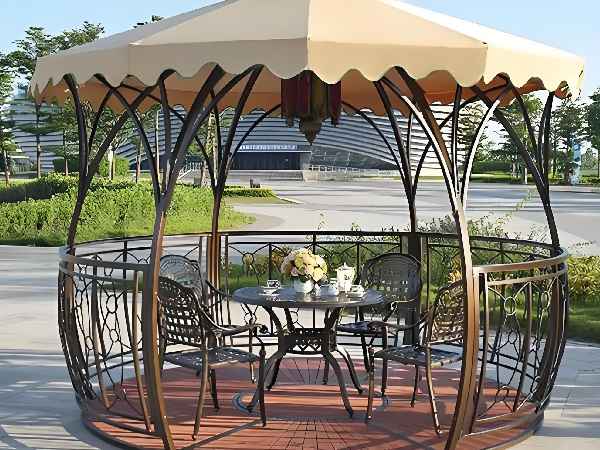
Wrought iron can be crafted into intricate shapes, making it ideal for vintage-style gazebos. You’ll often find it in European-style gardens, public parks, or restoration projects. Since these gazebos are mostly decorative, they’re best suited for fixed installations with solid foundations and long-term use.
5. Vinyl
Vinyl is a common composite material widely used for yard fencing, pergolas, and gazebo frames, especially popular in the North American market. Its advantages are clear: it’s corrosion-resistant, fade-proof, and almost maintenance-free. You don’t need to paint it, and it stays bright and clean with minimal effort. That said, vinyl doesn’t match metal when it comes to strength. Its load-bearing and wind-resistance capabilities are relatively limited, making it less suitable for large or permanent structures. Aesthetically, it also has a plastic-like look, which may not appeal to those seeking a natural or high-end finish like wood or wrought iron.
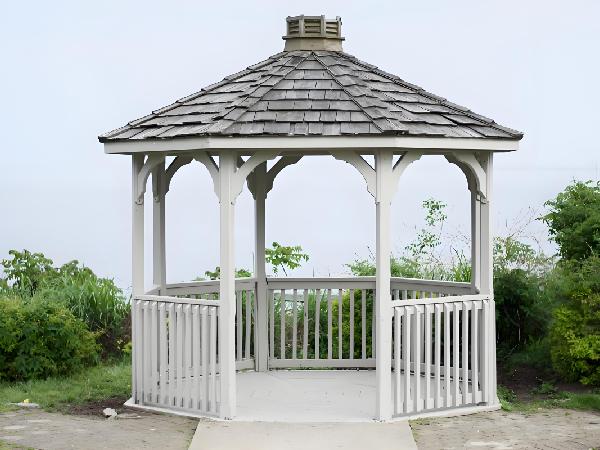
All in all, vinyl strikes a balance between ease of use, basic durability, and affordability. It’s a smart choice for small to mid-size gazebos, temporary setups, poolside areas, or rental properties where convenience and cost matter most.
6. Concrete
Concrete is a go-to material for building permanent gazebo or pavilion structures. Its stability and durability are unmatched by any of the other five materials. Resistant to wind, rain, and time, it offers outstanding load-bearing strength and long-term structural security — all with virtually zero maintenance. Of course, concrete comes with trade-offs. It takes longer to build, costs more upfront, and once poured and set, it can’t be moved or adjusted. That means careful planning is crucial before construction begins — any design change later on could be expensive and complex.
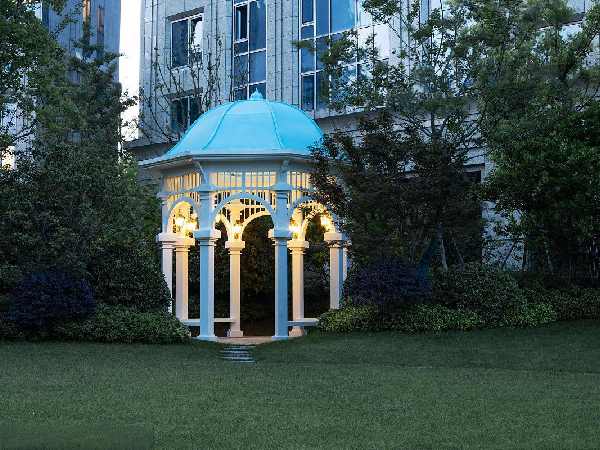
Overall, concrete is best suited for projects that demand exceptional long-term stability and structural strength, such as park pavilions, municipal plazas, or large commercial installations. If you’re planning a permanent build, have the budget, and require maximum safety, concrete is by far the most dependable choice.
Conclusion: How to Choose the Right Frame for Your Project
Choosing the right gazebo frame goes far beyond technical specifications. It’s about finding the right balance between budget, aesthetics, usage patterns, and environmental conditions. Each material comes with its own advantages — there’s no universal best, only the best fit for your specific project. For brand owners and bulk buyers, the frame material impacts more than just strength. It influences coating choices, corrosion resistance strategies, shipping logistics, and the degree of design customization available. If your project involves unique requirements, such as custom colors, reinforced structures, or specific bolt sizes, it’s crucial to communicate them early in the process to avoid delays or unexpected costs.
With decades of gazebo manufacturing experience and a strong track record in international projects, LIDA OUTDOOR is ready to support you from material selection to prototyping and full-scale production. We help you create gazebo products that are built to last — and built to sell.

